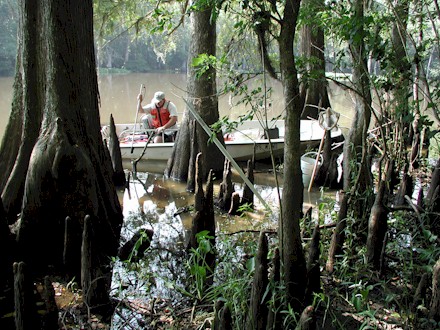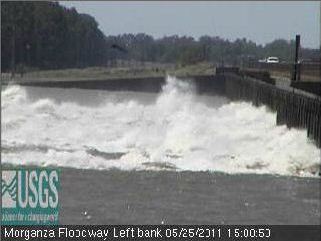Lower Mississippi-Gulf Water Science Center -- Louisiana

DATA CENTER
INFORMATION CENTER
ABOUT THE LOUISIANA WSC USGS IN YOUR STATE USGS Water Science Centers are located in each state. 
|
Water Resources of Louisiana“ . . . come in and see what we have for you!” Welcome to the United States Geological Survey web site for water resources in Louisiana. At this site, we present all sorts of useful information regarding one of Louisiana's greatest resources—water. Here you will find both real-time and historical data on many of the rivers, streams, and bayous in the state, as well as groundwater, water-quality, and water-use data. There are project descriptions and reports available that cover a wide variety of water-related topics, ranging from broad-based regional studies to tightly focused, in-depth investigations of specific regions in Louisiana. Many Federal, State, and local agencies as well as individual citizens rely on the data we gather and present here when making decisions regarding everything from ensuring public safety to scheduling recreational activities. So come in and see what we have for you!
Baton Rouge area experiences flooding well above the benchmark flood of 1983
Basic Water Resource Information Made Easy—Parish Fact SheetsThe USGS is summarizing basic information on water resources for each parish in Louisiana and presenting the information in fact-sheet format. Information presented includes groundwater and surface-water availability, quality, development, use, and trends. These brief summaries of water resources will provide parish officials, local officials and concerned citizens with information needed to make decisions about current and future development in their parish. So where can you get your hands on this great resource? Right here, right now. New Tool for Evaluation of Baton Rouge's Saltwater IntrusionA new USGS groundwater model provides a tool for evaluating possible solutions to the saltwater encroachment in the "2,000-foot" sand aquifer of the Baton Rouge area, an important source of groundwater for Baton Rouge. Check out the press release to get more information about the report, or you can download a full PDF version of the report. Water Use—What Do We Do With All That Water?Water plays a critical role in practically every aspect of our lives. We all know we must have water to survive, but water is also necessary to support farming, industy, power generation, aquaculture, recreation, and much more. In Louisiana, we are blessed with a vast abundance of water. So how is all that water used? Check out our completely new and remodeled Water Use web pages and find out! WaterAlert—Water Conditions Delivered to YouDo you wish you could keep track of water conditions without having to constantly check our real-time web pages to see if something interesting is happening? Your wish is granted. Hurricane Season—LMGWSC has the Louisiana Coast Covered
June 1 marks the beginning of hurricane season. Should storms arrive on the Louisiana coast, the people in coastal communities across the State, along with many Federal, State, and local agencies will need to know how the storms are affecting the coastal and low-lying areas. The USGS maintains an extensive network of coastal gages that provides critical time-sensitive water level and other water and meteorological data in near-real-time. The USGS Lower Mississippi Gulf Water Science Center (LMGWSC) has created a web page that highlights this coastal network so that it is easy to find and examine the data collected at these locations. The image with this article is the current satellite image of the Gulf of Mexico as seen in the visible spectrum. Clicking the image will take you to the full-sized version. These images come from the NOAA Gulf of Mexico Imagery web page where you can find related imagery, including infrared images and image loops. Hardened Gages—Built to SurviveAlthough the USGS operates and maintains an extensive network of coastal sites, most of these gages are not built to withstand the full fury of a major storm. Here are the ones that are. Mississippi-Atchafalaya Flood 2011
The Aftermath The historic Mississippi River flood may be over, but there is much we can learn from the event. The LAWSC collected a lot of data from sites on the Mississippi River and in the Atchafalaya Basin that should provide us with a better understanding of how major flood events on the Mississippi River and opening the Morganza Floodway and the Bonnet Carré Spillway affect the Atchafalaya Basin, Lake Pontchartrain, and the areas along the lower reaches of the Mississippi River. Some of the web pages for this event will be kept in place to make this information easy to find and use. USGS Responds to Deepwater Horizon Oil SpillThe USGS is one of several Federal agencies that has been mobilized to help with the Deepwater Horizon Oil Spill. We have been charged with the task of gathering scientific data and information on the environmental impacts of the oil spill to affected coastal habitats. Find out more about how we are carrying out this task, and what other Department of the Interior agencies are doing. The Joint Information Center (JIC) is the official site of the Deepwater Horizon Unified Command. Keep up with events surrounding the oil spill through the JIC. Oil Spill Links
Additional Information and SourcesSources
Information
Streamflow Conditions in Louisiana |